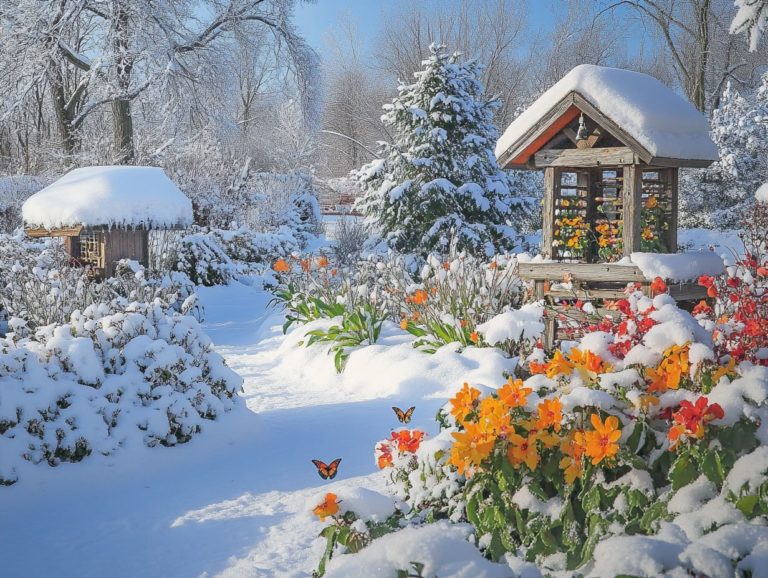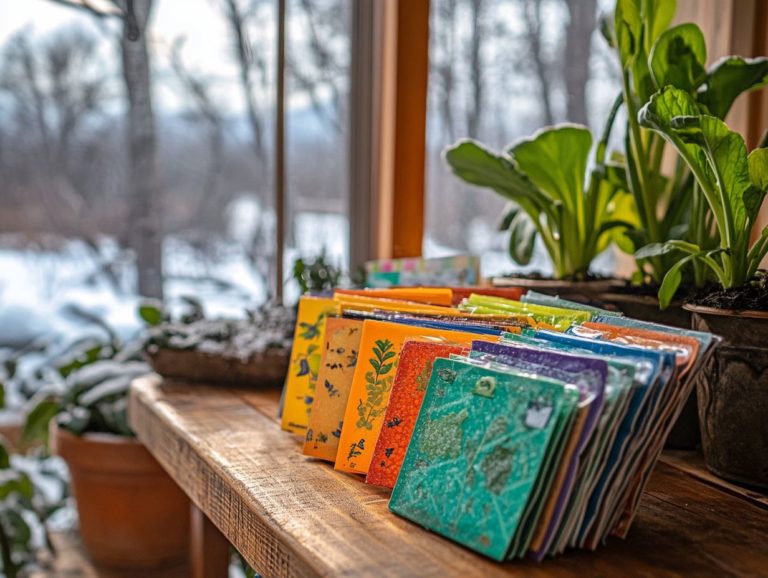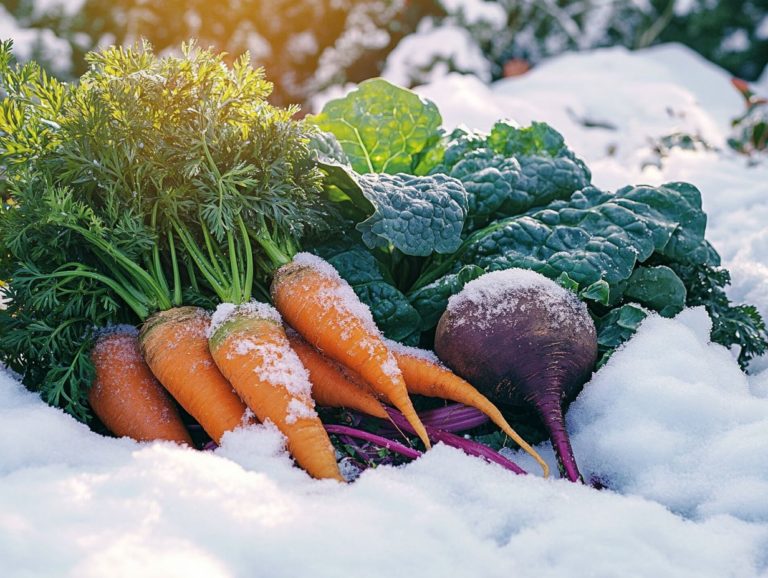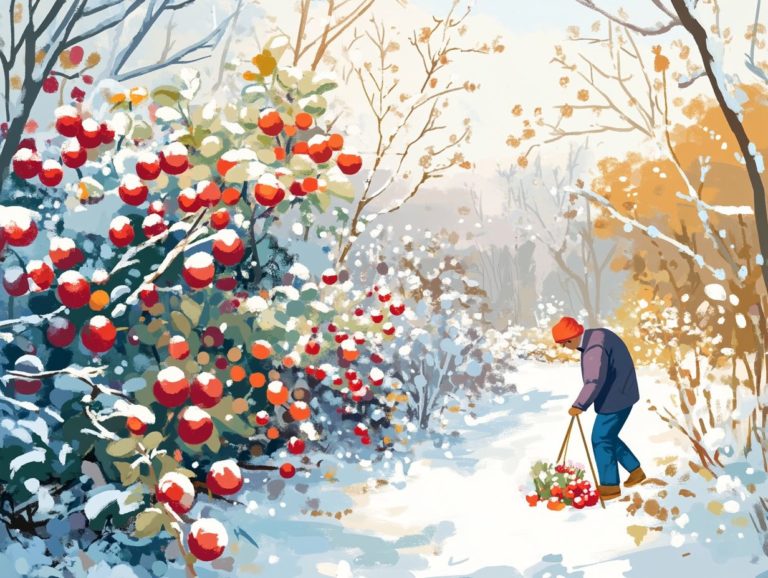How to Winterize Your Garden?
As the days become shorter and the chill of winter approaches, it s time to prioritize preparations for your garden. A garden that is well-winterized not only withstands the harsh months ahead but also lays the groundwork for a flourishing spring.
From cleaning and safeguarding your plants to tackling pests and diseases, this guide provides you with essential knowledge to ensure your garden thrives throughout winter. Whether you tend to a vegetable patch, a flower bed, or an herb garden, these tailored winterizing tips will empower you to cultivate a resilient garden, ready to burst into bloom when spring arrives.
Contents
Key Takeaways:

- Winterizing your garden is key to protecting your plants.
- Start by cleaning debris to kick off your winter prep.
- Proper watering, fertilizing, and preventing pests and diseases are essential for maintaining your garden during winter.
Why It’s Important
Winterizing your garden is crucial for safeguarding the health and vitality of your plants throughout the colder months. Proper preparation, as outlined in winterize your garden: essential steps to take, not only shields your flowers, vegetables, and perennials from frost damage but also boosts their resilience against harsh winter conditions.
By understanding the importance of winter gardening practices, you can create an environment that lowers the risk of pests and diseases while encouraging vigorous growth come spring. Dedicating time to winter preparation will nurture a thriving ecosystem that supports healthy plants and promises bountiful harvests in the seasons ahead.
Preparing Your Garden for Winter
Prepare your garden for winter by taking essential steps. This will help your plants, tools, and structures survive the cold months ahead. Start by cleaning your garden beds and removing any debris. Additionally, you can learn about best practices for winter gardening to ensure your plants thrive. Take the time to winterize your irrigation system to prevent damage from freezing temperatures.
Don’t forget to apply mulch and compost, which are materials added to enrich your soil and protect it during winter. By focusing on these seasonal tasks, you can create a protective haven for your vegetables, flowers, and perennials, effectively minimizing winter stress on your garden.
Cleaning and Clearing Out
Cleaning your garden is an essential step in winter preparation, ensuring that pests and diseases don t take up residence in your outdoor spaces. Start by removing dead plants, leaves, and any debris that might be sheltering unwanted pests or fungi.
This maintenance task not only looks great but also keeps your garden healthy! It enhances airflow and reduces the chances of fungal diseases affecting your perennials and annuals. By ensuring your garden beds are free from weeds before winter sets in, you minimize competition for nutrients when spring arrives.
A well-tended space encourages healthy growth and creates a welcoming environment for beneficial insects and pollinators during the warmer months, significantly lowering the risk of pest infestations.
Regularly tending to your garden can lead to a more vibrant landscape while supporting the overall ecosystem, allowing it to thrive and flourish in the following season.
Get started today! Your garden will thank you in the spring!
Protecting Plants and Structures
Protecting your plants and structures from harsh winter elements is essential for maintaining a flourishing garden ecosystem. You have a variety of methods at your disposal, such as insulating tender plants and using covers for outdoor containers to shield them from frost.
Using natural materials like straw or fabric can effectively safeguard your perennials against extreme temperature fluctuations. Position bird feeders wisely to help wildlife thrive even in the cold.
Act now to equip your garden to withstand winter’s challenges and lay the groundwork for a vibrant spring. One effective technique for insulating your plants is to wrap their bases with burlap, which is a coarse fabric used for wrapping plants, or utilize bubble wrap to trap heat, making a warm cover.
When dealing with outdoor containers, consider elevating them off the ground; this simple step helps prevent frost from seeping into the soil. Covering your containers with frost cloth or blankets adds an extra layer of protection. Ensuring that drainage holes remain unobstructed prevents any water accumulation that could lead to damage.
For garden structures like trellises or raised beds, adding protective screens or hoops with plastic covers can enhance insulation as well.
By employing these thoughtful strategies, you preserve the health of your plants and maintain the beauty of your garden throughout the chilly months.
Winter Maintenance for Your Garden

Effective winter maintenance for your garden is crucial to keeping your plants healthy and vibrant, even as temperatures drop. This means managing your watering schedules meticulously to prevent root damage from the cold.
Also, consider the nutrient needs of your soil during these chilly months. Using the right tools for maintenance can significantly enhance your efficiency in gardening tasks, enabling you to focus on nurturing the long-term health of your plants.
Prioritizing winter maintenance lays the groundwork for a seamless transition into spring gardening.
Proper Watering and Fertilizing
Proper watering and fertilizing are crucial elements of winter gardening that can profoundly influence the vitality of your garden beds.
As winter rolls in, chilling temperatures and shorter days inevitably affect plant growth, prompting you to reconsider how much and how often your plants need water. A thoughtful watering strategy maintains soil moisture and prevents issues like root rot from damaging your garden.
In addition, incorporating a balanced fertilizer that provides essential nutrients is key to fostering strong plant health. Ensure your winter crops are well-equipped to endure the stress of the cold.
Seek out slow-release fertilizers or those high in nitrogen to encourage lush foliage. Alternatively, opt for potassium-rich options that bolster overall plant vigor during this dormant season.
By refining these practices, you can lay the groundwork for a flourishing landscape, even amid the chill of winter’s embrace.
Preventing Pests and Diseases
Preventing pests and diseases during the winter months is essential for maintaining a healthy garden. This ensures your plants stay protected from harmful infestations.
Carefully inspecting for any signs of trouble, such as discolored foliage or unusual spots, allows you to identify potential threats early on. Along with organic treatments, using barriers like row covers adds an extra layer of defense against pests.
Establishing a routine that includes sanitizing your tools and equipment is crucial to prevent the spread of disease. Moreover, consider incorporating companion planting, which means planting certain plants together to help each other grow.
A comprehensive approach will create an environment where your plants can thrive, free from pests and diseases.
Transitioning Your Garden for Spring
Transitioning your garden for spring requires a thoughtful combination of planning, preparation, and execution to ensure a successful growing season ahead.
As winter gives way to spring, it’s essential to assess your garden’s needs and identify the tasks necessary for vibrant plant growth. This includes pruning, preparing the soil, and re-establishing irrigation systems.
By staying proactive and addressing potential challenges early on, you ll create an environment where your flowers, vegetables, and perennials can thrive, paving the way for a harvest.
Steps for a Successful Spring Garden
Starting your spring garden begins with planning and the thoughtful execution of planting techniques tailored to your plants. This means selecting the right seeds, understanding the climate zones where they thrive, and timing your planting schedule to unlock their full growth potential.
Consider the sunlight and moisture levels in your area to choose seeds that will truly thrive in your environment. For plants that need a longer growing period, start seeds indoors now to get ahead this season! Others can be directly sown after the last frost. Keeping a close eye on soil temperature will enhance your timing for optimal germination.
Incorporating companion planting techniques and rotating your crops will promote healthier plants and help minimize pest issues. Ultimately, these detailed approaches are vital for reaping the rewards of your spring gardening efforts.
Winterizing Tips for Different Types of Gardens
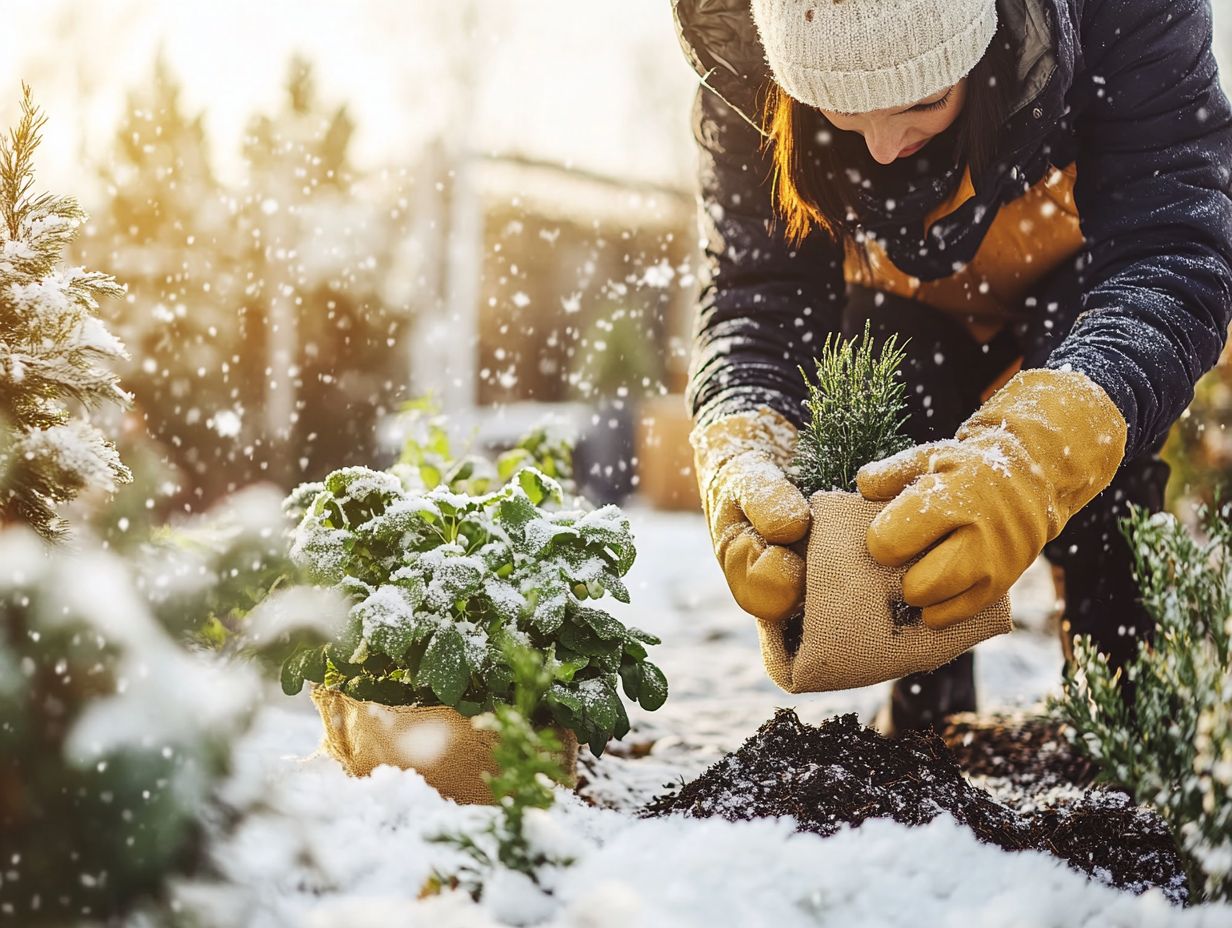
Winterizing your garden calls for a tailored approach based on the specific type of garden you cultivate, whether it’s a vegetable, flower, or herb garden. To ensure your plants thrive through the chilly months, follow the essential steps for preparing your garden for winter, as each type brings its own unique challenges and needs that you must address.
For example, vegetables might require extra protection against frost, while flowers and herbs benefit from careful pruning and mulching to preserve moisture and nutrients.
Understanding these distinctions is crucial for successful winterizing and maintaining plant health throughout the winter season.
Vegetable Gardens
Winterizing your vegetable garden is all about implementing strategies that shield your crops from frost while providing vital insulation to the soil. Start by mulching around hardy vegetables like broccoli and garlic; this helps retain moisture and enriches the soil as it breaks down. For more details, explore the best cold-weather gardening techniques.
Covering more sensitive plants with fabric or straw can also help mitigate frost damage, ensuring that they transition smoothly into spring. By taking these thoughtful precautions, you re setting the stage for a productive garden.
Proper winterizing goes beyond just adding coverage; it involves evaluating your garden’s layout to ensure every crop gets the protection it deserves. For example, planting cover crops like clover can boost soil health while providing a protective layer that keeps pesky weeds at bay during the winter months. Additionally, protecting your garden from winter pests is crucial to maintain its health.
As temperatures dip, adding a thick layer of mulch not only locks in moisture but also creates a barrier that regulates soil temperature, preserving the beneficial microbes your garden needs.
Incorporate organic matter into your soil to enhance its structure, ensuring a healthy environment for your plants.
Don t forget about regular maintenance checks! Removing debris and leaves is essential since they can harbor pests. By staying on top of this, you can keep your garden healthy and vibrant, no matter how chilly it gets outside.
Flower Gardens
Winterizing your flower gardens is an essential process that safeguards perennials and bulbs through the chilly months. Start by applying a generous layer of mulch to protect the roots and retain moisture. Specific pruning methods can help stave off disease and encourage robust growth in spring. To ensure you’re well-prepared, check out preparing your garden for the first frost and know your climate zone to choose the right protection for your flowers. By taking these steps, you can nurture a vibrant flower garden that flourishes as the seasons shift.
Incorporating annuals can add color and interest to your garden while providing additional layers of insulation for perennials.
Customize your winterizing methods based on the specific types of perennials and bulbs you ve planted. Some flowers may thrive if you cut back their foliage to stimulate new growth in spring, while others may prefer to keep their stems intact for added insulation.
Ensure proper drainage for bulbs by planting them in raised beds or amending the soil with organic matter. These practices not only protect your cherished plants but also improve the overall structure of your garden, ensuring it remains a breathtaking focal point year after year.
Herb Gardens
When winterizing your herb garden, shield those tender plants from freezing temperatures while maintaining a clean and well-kept space. Insulating your herb beds with organic materials like straw or leaves provides the warmth necessary to safeguard herbs such as strawberries and garlic throughout winter. Covering your garden with frost cloth offers extra protection against harsh winds and unexpected cold snaps.
Remove any dead herbs or debris to prevent diseases from taking root and create a thriving environment for your herbs when spring arrives. Implementing these winterizing steps will set you on the path to a flourishing herb garden.
Regular maintenance checks are key to ensuring the health of your gardens. Before winter settles in, assess the soil’s moisture levels; overly damp soil can lead to root rot, so a light winter watering may be just what you need.
Additionally, create a protective barrier around your herb beds, like burlap screens, to shield sensitive plants from biting winds and excessive snow. Start now to ensure your herb garden rebounds beautifully when warmer months return.
Frequently Asked Questions
What does it mean to “winterize” your garden?
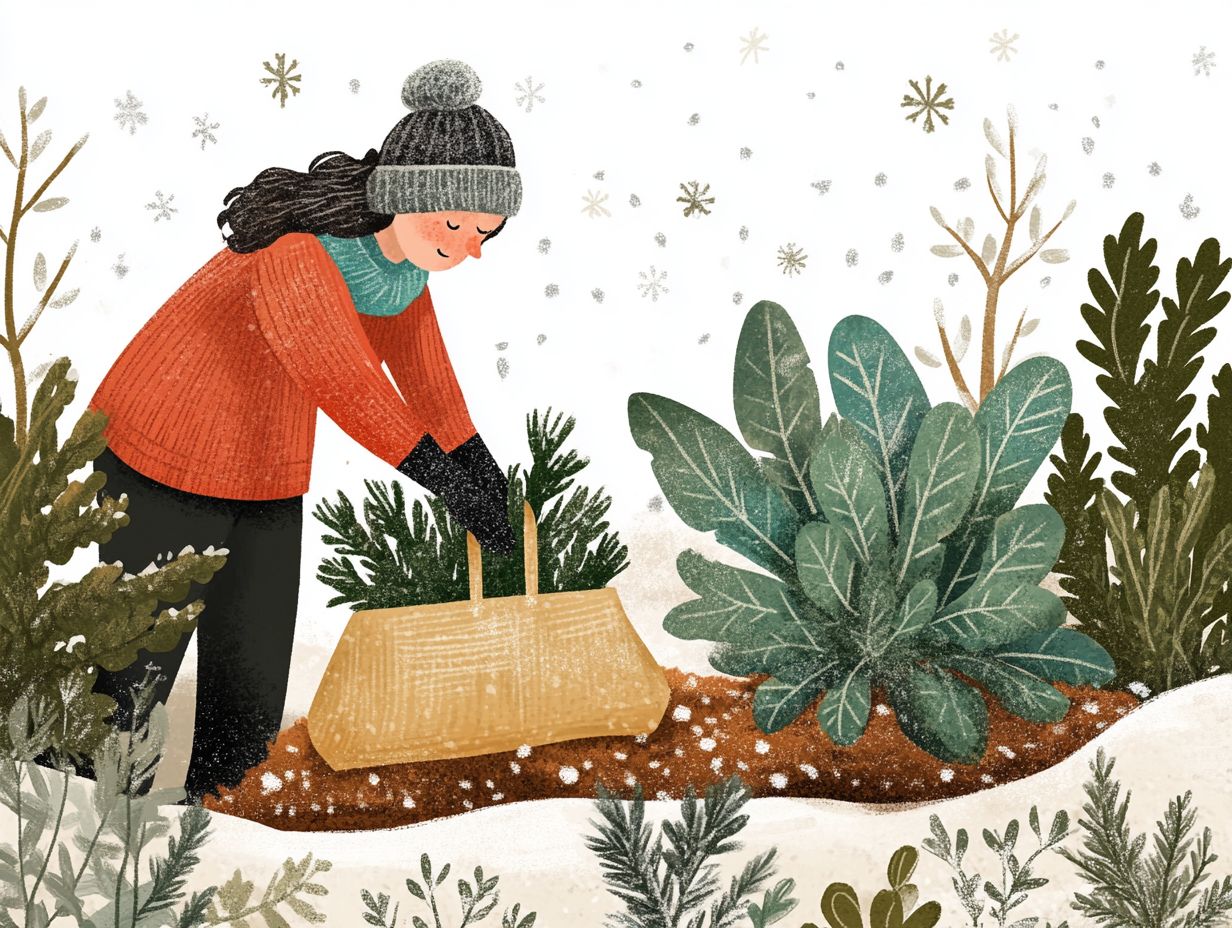
Winterizing your garden refers to preparing your garden for winter, including your plants, soil, and garden space for the colder temperatures and harsh conditions. This will help protect your plants and ensure they survive until the next growing season.
When should I start winterizing my garden?
The best time to start winterizing your garden is when temperatures consistently begin to drop below freezing at night. This varies depending on your location, but typically occurs in late fall. Give your plants time to adapt; they ll thank you in spring!
What should I do with my plants when winterizing my garden?
First, remove any dead or dying foliage and weeds from your garden. Then, trim back perennials to prevent disease and promote new growth in spring. Cover your plants with a layer of mulch or compost to protect their roots and retain moisture.
Do I need to prepare the soil for winter?
Yes, it’s important to prepare your soil for winter. Remove any plant debris and till the soil to loosen it. This will help improve drainage and prevent compaction. Add a layer of compost or organic matter to enrich the soil for the next growing season.
How can I protect my garden from freezing temperatures?
If your area freezes, protect your garden from frost. Cover plants with a cloth or blanket to trap heat and prevent damage.
What else should I do to winterize my garden?
Prepare your plants and soil. Clean and store your gardening tools properly.
Drain and store your hoses. Clean and sharpen your tools, then keep them in a dry place to prevent rust.
Finally, clean and disinfect your pots or containers before storing them for winter.


